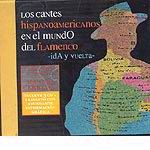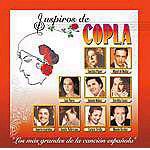- Contact |
-
Phone |
(+34) 91 542 72 51.
We’re open from Monday – Friday 10h-13:30h / 17:00-20:00h and Saturdays 10h-13:30h (GMT + 1).
In 2022, we will be closed for holidays the 1st and 6th January, 14th, 15th and 16th April, 2nd and 16th May, 25th July, 12th October, 16th August, 1st and 9th November, 6th, 8th , 9th and 26th December.
Our shop is located in Calle Campomanes nº 4, Madrid 28013 España (Ópera Metro Station) - Help |
- Price list |
- Order situation |
- Wholesalers Access
- 🚚 📦 WORLDWIDE SHIPPING ✈️ 🌍

Imperio Argentina
Imperio Argentina
Magdalena Nile del Río was born in San Telmo neighborhood, at Buenos Aires, on December 26, 1906. Her parents were Spanish and English descent.
He made her artistic debut at the "Comedia" theatre in that same city under the stage name of Petit Imperio, being her artistic mentor the Spanish dancer and variety singer Pastora Imperio.
She soon moved to Spain, where she took dancing lessons and, after choosing a new stage name, Imperio Argentina, made her debut at Madrid's "Romea" theatre in 1924. For a while, she was touring Spain and making her first recordings.
The film director Florián Rey chose her in 1927, as the star female of "La hermana San Sulpicio", a silent movie based on a novel by Armando P. Valdés.
In 1928 she traveled to Germany to appear in "Corazones sin rumbo", a film that only remain a few minutes of this movies nowadays. Also starred in "Los claveles de la Virgen" produced in Spain.
By now, Imperio Argentina's repertoire included tangos in the "arrabalero" style, Argentinean waltzes, "habaneras" and popular Cuban tunes.
The arrival of the "talkies" and the musical comedies led her to move to Paris, where she is fired as a film star, working at Joinville studios, in Paramount Spanish spoken productions "El profesor de mi mujer" (1930), "Cinépolis" (1931) among other films. She also had enormous success with the Spanish version of "Her Wedding Night": "Su noche de bodas", directed by Louis Mercanton and Florián Rey. In that movie she sings the waltz "Recordar" -a song of universal popularity-, in a duet with Manuel Russell.
Subsequent movies of this period were "Lo mejor es reír", the Spanish version of "Rive Gauche", directed by Alexander Korda and co-performed by Manuel Russell and Rosita Díaz, among others. After that "¿Cuándo te suicidas?", and the short features "El cliente seductor" (1932), besides Maurice Chevallier.
In Paramount productions she performed alongside Carlos Gardel in "La casa es seria" (1930) and "Melodía de arrabal" (1932), this film made her enormously popular in America.
At this time she made some successful recordings with the singer and guitarist Rafael Medina for Parlophone. Besides waxing several Cuban numbers and a version of the "Carioca", a dance hit first popularized by Ginger Rogers and Fred Astaire in "Flying to Rio".
She also did some tangos, mainly from the repertoire of Tania and Libertad Lamarque. Her sole competitor in Spain was the Catalan vocalist and actress Carmencita Aubert (she adopted the name Carmelita since 1935). Titles like "Danza maligna" and "Hacelo por la vieja", were recorded by both singers, Aubert for Parlophone and Imperio Argentina for Odeon. The legendary artistic rivalry between them is still discussed upon by experts and collectors.
In 1934 Imperio appeared alongside Miguel Ligero in the film "El novio de mamá", directed by Florián Rey. In July, that same year, Imperio and Rey got married. Rey had recently divorced his first wife Pilar Torres, thanks to the divorce laws passed by the Spanish republican parliament.
After starring in a talking version of "La hermana San Sulpicio", she performed in the short feature "Romanza rusa", whose musical director was Manolo Salinger, a reputed jazz critic who in the forties became art director at "His master voice". In this film she sang the Russian folksong "Black eyes", made famous by Al Jolson in "Wonderbar".
In 1935 Imperio and Florián made the film version on "Nobleza baturra", a "provincial" musical comedy which became an astounding box-office success all through Spain. After that, another typical film with Andalusian background "Morena clara", a musical comedy by Quintero and Guillén, which became another huge hit.
The outbreak of the Spanish Civil War in 1936 found them in Paris, preparing a new movie which was to be called "La casta Susana". This project suspended they moved to Miami, and then to Cuba, Puerto Rico and Mexico, where they were extremely popular. In 1938, back in Europe, they worked in an couple of films in Germany.
Imperio Argentina's career lasted for decades and included countless radio, cinema, theatre and TV appearances.

















